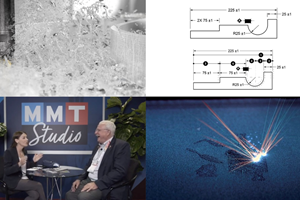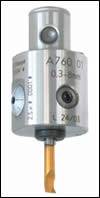How to Use Indexable Tooling to Optimize Finishing Operations
High-quality indexable insert end milling systems offer moldmakers considerable cost-advantages for many finishing operations.
Finishing operations in moldmaking represent the least amount of metal removal, but the greatest amount of time-up to 50 percent of the entire machining operation. With the introduction of sophisticated CNC machines producing very tight tool paths, time required for secondary finishing operations can greatly be reduced. But, the cutting tool being used is just as influential as the machine. It's estimated that close to 70 percent of shops in the U.S. involved in machining for the mold and die industry are still using solid carbide tools for finishing operations. Solid carbide can get the job done, but in many instances, operators underuse the tool and run the machine at a slower rate to avoid possible tool breakage and gain tool life. Today, the availability of high-quality indexable insert end milling systems offer considerable cost advantages for many of these finishing operations. Modular tooling systems offer almost unlimited combinations of inserts and shanks to customize the tool for your application.
Increased Advantages
One of the strongest advantages is increased productivity. For example, a modular system can provide increased rigidity, contrary to conventional thinking that a solid carbide monoblock tool would be the better choice. The difference is that a modular system offers the ability to mix and match shank to diameter ratio, actually enhancing the rigidity of the tool. Tool length is determined by the available shank styles, which are selected according to the operation to be performed. The longest shanks meet any accessibility requirements, while also providing the needed stability for good machining performance. This includes increased feeds and speeds for higher productivity, and less tool vibration for better surface finish and longer tool life.
This increase in rigidity leads to reduced cycle times. Machine feeds and speeds actually can be increased up to 20 to 30 percent faster as compared to long reach solid carbide applications. Also, there is an improvement in tool life. Modular tooling systems feature premium grades of carbide with coating at the same price that you'd get a medium-grade solid carbide tool.
Some cutters come equipped with through-spindle coolant as a standard. This is an expensive option on solid carbide tools. These holes ensure that the coolant flow hits exactly the right spot and improves chip evacuation. By switching finishing operations to a versatile end milling system, you can expect an average cycle time reduction of 15 to 20 percent, coupled with a 5 to 10 percent increase in tool life in most cases. The potential for cost savings can be tremendous. In addition, the improved quality obtained by finishing with a modular tooling system can significantly reduce the time required for secondary finishing or benchwork operations.
Improving Cost and Quality
There also are other more obvious cost-savings benefits. When a solid carbide tool breaks, the entire tool must be replaced at a new-tool cost. By contrast, with an indexable system, a broken insert can be replaced for just a few dollars. Indexable insert tools also eliminate the need for regrinding, which is labor-intensive and costly. Plus, you start with a new, consistent, fresh cutting edge after every insert exchange, improving quality.
Versatility also is key. With a modular tooling system, there is the flexibility to use different inserts with the same cutter body. In many cases, only a simple change of insert grade or geometry is needed to equip the same cutter body for use in different materials or operations, saving both time and money.
Although best suited for high-speed CNC machines, modular end milling systems also can yield advantages for older machines. But, due to the machine speed and feed limitations, costs savings will be accrued mostly through longer tool life.
In general, applications that require a depth of cut over three times the tool diameter would benefit from an indexable insert end mill system. Modular end milling systems can provide cycle time reduction, improved quality and cost savings as compared to solid carbide tooling. Also, there is always a combination shank and insert available to minimize tool overhang, adding stability to your operation.
Related Content
Modular Tooling Systems Enable Versatility in Hole-Drilling Operations
The versatility of replaceable cutting edges offers users the ability to adapt to varied operations.
Read MoreHow to Use Continuing Education to Remain Competitive in Moldmaking
Continued training helps moldmakers make tooling decisions and properly use the latest cutting tool to efficiently machine high-quality molds.
Read MoreBuilding Molds: Most Popular Reads of 2024
Dive into the most-viewed content for building your mold, including topics such as cutting tools, EDM, hot runners, additive manufacturing, mold materials, machining and mold components.
Read MoreTolerancing in Mold Design, Overcoming Cutting Tool Vibration, SPE MTD Updates & More Most-Viewed May Content
Every month, MMT draws inspiration from its diverse readership's wide-ranging interests, from mold design tolerancing to cutting tools and beyond. Here are May’s top 10 most-viewed articles, based on Google Analytics.
Read MoreRead Next
Maximum RPM Machining: Necessities of High-Speed Moldmaking
Mold shops will thrive if they practice an ‘all-aspects’ process to HSM, which includes the machine, cutting tool, toolholder, proper balance and application support.
Read MoreReasons to Use Fiber Lasers for Mold Cleaning
Fiber lasers offer a simplicity, speed, control and portability, minimizing mold cleaning risks.
Read MoreAre You a Moldmaker Considering 3D Printing? Consider the 3D Printing Workshop at NPE2024
Presentations will cover 3D printing for mold tooling, material innovation, product development, bridge production and full-scale, high-volume additive manufacturing.
Read More.png;maxWidth=970;quality=90)












.png;maxWidth=300;quality=90)








